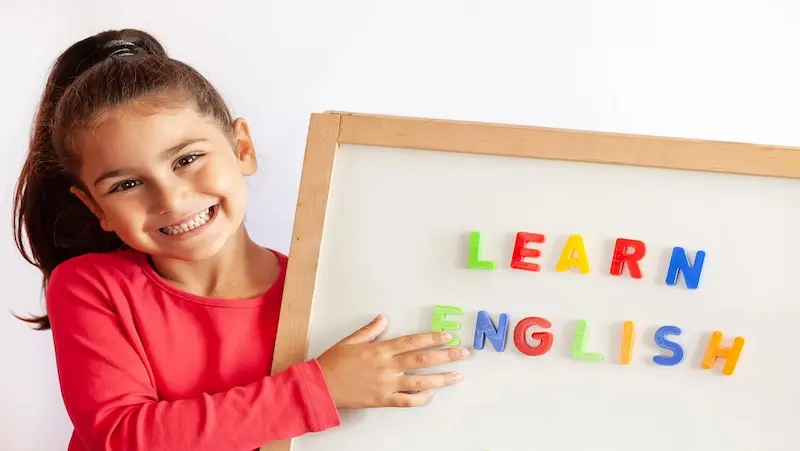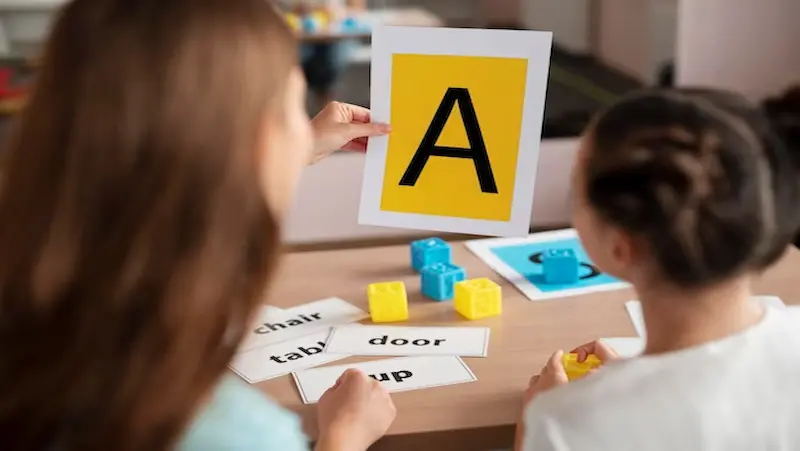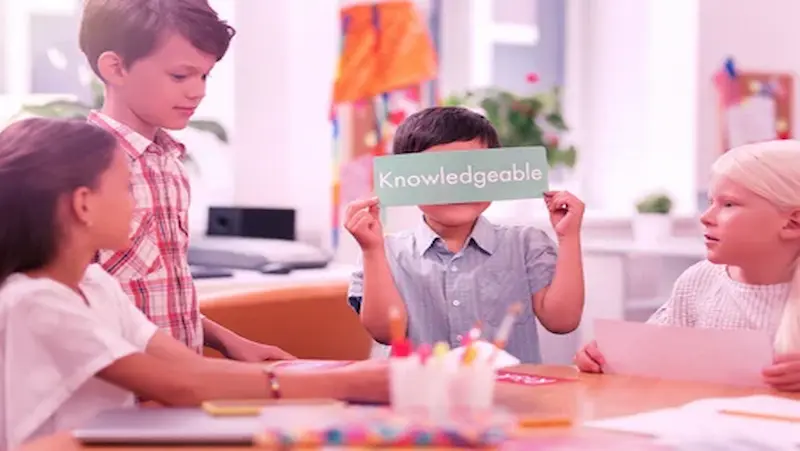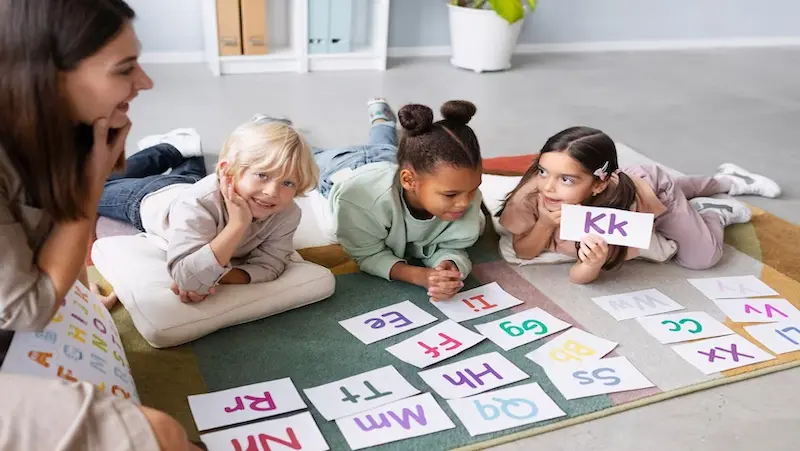Are you ready to embark on a fun-filled journey of English learning? Do you want to discover new words, express your thoughts with confidence, and make friends from all over the world?
Well, look no further! Welcome to Engaging English Learning for Kids, where we believe that learning should be exciting, interactive, and tailored just for you. Get ready to dive into captivating stories, interactive games, and creative activities that will ignite your imagination and bring English to life. Let’s begin this incredible adventure together!
Table of contents
Introduction
English learning for kids is of paramount importance in today’s globalized world. May be, make them learn English is the best parenting advice you ever got in this era, because it opens up a world of opportunities, enabling children to communicate effectively with people from different cultures and backgrounds. Learning English at an early age offers numerous benefits.
Firstly, it enhances cognitive development in children, improving memory, problem-solving skills, and critical thinking skills for kids. Secondly, it boosts their confidence as they gain proficiency in expressing themselves in a widely spoken language.
Additionally, it broadens their horizons by providing access to a wealth of information, literature, and diverse perspectives. Moreover, English proficiency equips children with a competitive edge in their academic and professional pursuits.

Why Choose Interactive Learning?
Using interactive methods to teach English to kids offers a range of advantages that promote effective learning and engagement. If you can give it to them at the early childhood stage, it will be good. Early childhood learning lays a strong foundation.
Firstly, interactive methods create an active learning environment where children are actively involved in the learning process. This promotes better comprehension, retention, and application of children’s language development.
Secondly, interactive methods make learning enjoyable and fun. By incorporating games for kids, puzzles, songs, and multimedia resources, children become more motivated and enthusiastic about learning English. They actively participate, explore, and experiment with the language, making the learning experience memorable and exciting.
Furthermore, in this digital era where kids sit in front of screens most of the time, parent’s question is “How to improve communication skills for students?”. Yes, it is the question most parents and teachers asking now. So, here is the one solution.
Interactive methods facilitate hands-on practice and real-life language application. Through role-plays, group activities, and discussions, children practice their English skills in authentic situations, enhancing their communication abilities.
Interactive methods also cater to different learning styles and preferences. Visual learners benefit from videos and images, auditory learners thrive through songs and audio materials, and kinesthetic learners engage through interactive exercises and physical activities. This approach ensures that all children can learn effectively according to their individual strengths.
Additionally, interactive methods foster collaboration and social interaction. Through pair work, group projects, and language games, children develop their communication and teamwork skills. They learn to express their thoughts, listen actively, and respect diverse perspectives, building their social and interpersonal skills.
Overall, using interactive methods not only facilitates language acquisition but also nurtures a positive attitude toward learning, boosts confidence, and promotes a lifelong love for English.

Fun Activities for English Learning
Here’s a list of interactive and enjoyable activities that parents can try with their kids to enhance their English learning:
1. Storytelling Sessions: Take turns telling stories for kids to each other, encouraging imagination, vocabulary building, and listening skills.
2. Word Scavenger Hunt: Create a list of English words related to a theme or category and have your child find objects or pictures that represent those words.
3. Sing-Along: Sing English songs together, using lyrics or karaoke-style videos. This improves pronunciation, vocabulary, and listening skills.
4. Role-Play: Act out scenarios using English, such as a pretend restaurant or doctor’s office, allowing children to practice conversational skills and vocabulary in a fun way.
5. Board Games: Play language-based board games like Scrabble, Boggle, or Bananagrams, promoting spelling, vocabulary, and strategic thinking.
6. Puppet Show: Encourage your child to create a puppet show in English, using puppets or even homemade sock puppets. This activity enhances creativity, storytelling, and speaking skills.
7. Cooking Adventure: Cook a recipe together, following instructions in English. This activity introduces new vocabulary, and measurement skills, and encourages reading comprehension.
8. Virtual Pen Pals: Connect with children from different countries through online platforms or language exchange programs. This allows kids to practice English while making new friends.
9. Picture Dictionaries: Create a personalized picture dictionary with your child, where they drawing for kids or cut out pictures of English words they have learned. This reinforces vocabulary and visual association.
10. Outdoor Language Exploration: Take a nature walk or visit a park, encouraging your child to describe what they see in English. This activity develops observation skills, descriptive language, and appreciation for the environment.
Remember, the key is to make these activities interactive, enjoyable, and age-appropriate, ensuring that they spark your child’s interest and enthusiasm for learning English.

Educational Resources for Kids
Here are some online and offline resources that can aid in English learning for kids:
Websites
1.LingoCHAMPS (https://brightchamps.com/lingochamps )
LingoCHAMPS is an online 1:1 platform that focuses on developing confident communication and leadership skills in children. The unique selling point includes a team of the top 1% of global educators who are trained to nurture children’s interest, curiosity, and learning.
A futuristic curriculum designed by a global advisory of industry experts and top universities, and access to international hackathons. The journey for kids includes five modules, starting with the ABCs of Learning and progressing to mastering public speaking. Each module includes a set of skills that children develop, and upon completion of each module, they receive a certificate. The curriculum includes five pillars: public speaking, creativity, personality development, communication, and collaboration.
2. Funbrain (funbrain.com)
Offers interactive games, epic books for kids, and videos for kids of different ages to improve reading and language skills.
3. Starfall (starfall.com)
Provides engaging phonics activities for kids, stories, and songs to enhance early reading and vocabulary development.
4. ABCmouse (abcmouse.com)
Offers a comprehensive curriculum of interactive activities, books, and free games for kids covering various subjects, including English language learning.
5. British Council LearnEnglish Kids (learnenglishkids.britishcouncil.org)
Provides a wide range of resources, including games, videos, songs, and stories, for children to learn English in a fun and interactive way.
Books
1. “The Very Hungry Caterpillar” by Eric Carle: A beloved children’s book that introduces vocabulary, colors, and numbers in an engaging story.
2. “Brown Bear, Brown Bear, What Do You See?” by Bill Martin Jr. and Eric Carle: Teaches animals, colors, and repetitive phrases through beautiful illustrations.
3. “Dr. Seuss’s ABC” by Dr. Seuss: An entertaining book that introduces the alphabet and rhyming words.
Apps
1. Duolingo (duolingo.com): A popular language-learning app that offers English courses specifically designed for kids.
2. ABC Kids – Tracing & Phonics (available on iOS and Android): Helps children learn letter tracing, phonics, and basic vocabulary through interactive games.
3. Endless Alphabet (available on iOS and Android): Teaches vocabulary and word recognition through fun facts for kids, animated puzzles, and interactive activities.
Games
1. Scrabble Junior: A simplified version of the classic board game that helps kids practice spelling, vocabulary, and word formation.
2. Apples to Apples Junior: A card game that encourages children to match words and develop their language skills while having fun.
3. Sight Word Bingo: A game that reinforces sight word recognition, helping children build their reading fluency.
These resources provide a combination of entertainment and educational activities for kids content, making the English learning experience enjoyable and effective for kids.

5 Fun English Learning Games And Activities
1. Fish Me A Word
- Guide your child to cut 12 shapes of fish out of the white construction paper.
- Write one word from the list of simple words on each paper fish using a pen.
- Encourage your kid to decorate the fishes with the help of colorful crayons.
- Attach one paper clip to each paper fish.
- Tie one wooden spoon at one end of the string and a magnet to its other end. Use the spoon as the fishing rod.
- Now, spread 12 paper fish on the ground and tell your kid to use the fishing rod and fish out a paper fish that has the word that you will spell out.
- Call out one word, your child will bring the magnet attached to the fishing rod near the paper clip attached to the fish having your said word, and catch the paper fish.
- Every time your child picks the perfect one tell her to spell the entire word loudly. This is a fun and interactive game for kids to learn English words.
2. Alphabet Hunt
- Create a column on the left side of a big cardboard sheet and tell your child to write all 26 alphabets in that column starting from A in the first row and ending with Z in the last row.
- Now, give your kid the last issue of a children’s magazine that contains lots of images, and ask her to hunt for a picture that begins with each alphabet. For instance, tell your little learner to find a picture that starts with ‘A’ like an apple or airplane. Write the name of the image in the front of alphabet ‘A’ on the cardboard. You can also help her cut out the image and paste it across A on the cardboard.
- The game continues till your kid finds images for the alphabet.
3. Word Recognition Activity
- Write some simple words, which are easy to represent with pictures, on one set of index cards.
- Cut images of the written words from the old magazines and glue them on the other set of index cards.
- Spread all the index cards facing up on the table, and tell your kid to match each written word with its corresponding image. The activity completes after your child matches all the words with their related images. It can be one of the best games to practice English comprehension for kids.
4. Blindfold Guess
- Spread lots of plastic objects, such as plastic animals, balls, and other toys that children can easily recognize just with a touch.
- Blindfold the kids one by one and tell them to touch the objects with their hands and guess them.
- Kids should name the objects that they feel with the spellings.
- In addition to sharpening their sensory motor skills, this is an entertaining way of identifying common household objects.
5. Simon Says Spell
- Gather a group of kids and acquaint them with various objects.
- Tell them that you will mention a letter in a sentence and children need to find and touch the object. For instance, you will say ‘Simon says touch an object beginning with ‘B’’ Then students need to figure out objects in the surroundings, such as a ball, bin, boots, and other items starting with B, and touch them.
- If a kid feels a wrong item by mistake, she is out. This is one of the interesting activities to learn and enhance English for kids in an easy way.

Expert Tips for Teaching English to Kids
Here are some practical advice and strategies from experts to help parents effectively teach English to their children:
1. Start Early: Introduce English as early as possible, as young children have a natural ability to learn languages. Create a language-rich environment by using English in daily routines, conversations, and activities.
2. Be a Language Model: Speak English consistently around your child, modeling correct pronunciation, grammar, and vocabulary. Use simple and clear sentences, and repeat or rephrase if needed.
3. Use Visuals and Real-Life Examples: Incorporate visuals, flashcards, or real objects to associate English words with their meanings. Use real-life examples to explain concepts and make connections to your child’s experiences.
4. Read Together: Read English free books for kids aloud to your child regularly. Use expressive voices, and gestures, and ask questions about the story to promote comprehension and critical thinking.
5. Encourage Active Listening: Play English audio materials, such as songs, stories, or podcasts, and encourage your child to listen actively. Discuss the content and ask questions to check their understanding.
6. Make Learning Fun: Use interactive and engaging activities, such as games, songs, role-plays, and puzzles, to make learning enjoyable. Incorporate elements of play and creativity to maintain your child’s interest.
7. Set Realistic Goals: Set achievable goals based on your child’s age and language proficiency level. Break down learning into small, manageable steps and celebrate their progress along the way.
8. Provide Positive Reinforcement: Praise and encourage your child’s efforts, progress, and achievements in learning English. Create a supportive and nurturing environment where mistakes are seen as opportunities to learn and grow.
9. Utilize Technology: Explore age-appropriate educational apps, websites, and online resources that offer interactive English learning activities. Supervise your child’s screen time and ensure the quality and relevance of the content.
10. Seek Language Exposure: Expose your child to English outside the home as well, through playgroups, language classes, cultural events, or online platforms for language exchange. This provides additional opportunities for practice and interaction.
Remember, consistency, patience, and a positive attitude are key when teaching English to your child. Tailor your approaches to their learning style and interests, and enjoy the journey of language learning together.

Conclusion
In conclusion, teaching English to children can be a rewarding and enriching experience for both parents and their little ones. By following the practical advice and strategies shared by experts, parents can create a language-rich environment that fosters effective English learning.
Starting early, being a language model, and incorporating visuals and real-life examples help children grasp the language more naturally. Reading together, encouraging active listening, and making learning fun through interactive activities keep children engaged and motivated.
Setting realistic goals, providing positive reinforcement, and utilizing technology appropriately further enhance the learning experience. Additionally, seeking language exposure beyond the home environment widens their linguistic horizons.
With consistency, patience, and a positive attitude, parents can nurture their children’s English skills while cultivating a lifelong love for learning. Together, parents and children embark on an exciting journey of exploration, communication, and growth, as they embrace the world of English language proficiency.
To get your hands on more such educational and free resources on coding, robotics, game development, etc., do check out the Brightchamps Page now! Learn about coding for kids too.
Frequently Asked Questions
The best methods to teach English to kids involve incorporating interactive activities, storytelling, songs, and games, and creating a language-rich environment that fosters active learning and engagement.
Yes, there are several online resources for kids to learn English, such as Duolingo, LingoCHAMPS, Funbrain, Starfall, ABCmouse, and the British Council LearnEnglish Kids website, among others.
You can make English learning fun and engaging for your child by incorporating interactive activities, games, songs, and storytelling, and using multimedia resources that align with their interests and learning style.
Some interactive activities to improve kids’ English skills include storytelling, role-plays, word scavenger hunts, sing-alongs, board games, puppet shows, virtual pen pals, and outdoor language exploration.
Yes, some recommended English learning apps for kids include Duolingo, ABC Kids – Tracing & Phonics, and Endless Alphabet, which provide interactive and engaging language-learning experiences tailored for children.


 We are an army of educators and passionate learners from BrightChamps family, committed to providing free learning resources to kids, parents & students.
We are an army of educators and passionate learners from BrightChamps family, committed to providing free learning resources to kids, parents & students.








